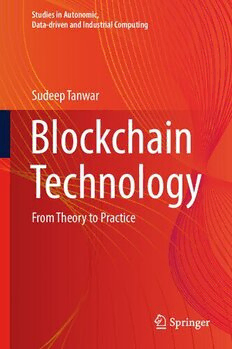
Blockchain Technology: From Theory to Practice PDF
Preview Blockchain Technology: From Theory to Practice
Studies in Autonomic, Data-driven and Industrial Computing Sudeep Tanwar Blockchain Technology From Theory to Practice Studies in Autonomic, Data-driven and Industrial Computing SeriesEditors SwagatamDas,IndianStatisticalInstitute,Kolkata,WestBengal,India JagdishChandBansal,SouthAsianUniversity,Chanakyapuri,India The book series Studies in Autonomic, Data-driven and Industrial Computing (SADIC)aimsatbringingtogethervaluableandnovelscientificcontributionsthat address new theories and their real world applications related to autonomic, data-driven, and industrial computing. The area of research covered in the series includes theory and applications of parallel computing, cyber trust and security, grid computing, optical computing, distributed sensor networks, bioinformatics, fuzzycomputinganduncertaintyquantification,neurocomputinganddeeplearning, smart grids, data-driven power engineering, smart home informatics, machine learning,mobilecomputing,internetofthings,privacypreservingcomputation,big dataanalytics,cloudcomputing,blockchainandedgecomputing,data-drivengreen computing, symbolic computing, swarm intelligence and evolutionary computing, intelligent systems for industry 4.0, as well as other pertinent methods for autonomic,data-driven,andindustrialcomputing. Theserieswillpublishmonographs,editedvolumes,textbooksandproceedings of important conferences, symposia and meetings in the field of autonomic, data-drivenandindustrialcomputing. Moreinformationaboutthisseriesathttps://link.springer.com/bookseries/16624 Sudeep Tanwar Blockchain Technology From Theory to Practice SudeepTanwar DepartmentofComputerScience andEngineering InstituteofTechnology NirmaUniversity Ahmedabad,India ISSN 2730-6437 ISSN 2730-6445 (electronic) StudiesinAutonomic,Data-driven andIndustrialComputing ISBN 978-981-19-1487-4 ISBN 978-981-19-1488-1 (eBook) https://doi.org/10.1007/978-981-19-1488-1 ©TheEditor(s)(ifapplicable)andTheAuthor(s),underexclusivelicensetoSpringerNature SingaporePteLtd.2022 Thisworkissubjecttocopyright.AllrightsaresolelyandexclusivelylicensedbythePublisher,whether thewholeorpartofthematerialisconcerned,specificallytherightsoftranslation,reprinting,reuse ofillustrations,recitation,broadcasting,reproductiononmicrofilmsorinanyotherphysicalway,and transmissionorinformationstorageandretrieval,electronicadaptation,computersoftware,orbysimilar ordissimilarmethodologynowknownorhereafterdeveloped. Theuseofgeneraldescriptivenames,registerednames,trademarks,servicemarks,etc.inthispublication doesnotimply,evenintheabsenceofaspecificstatement,thatsuchnamesareexemptfromtherelevant protectivelawsandregulationsandthereforefreeforgeneraluse. Thepublisher,theauthorsandtheeditorsaresafetoassumethattheadviceandinformationinthisbook arebelievedtobetrueandaccurateatthedateofpublication.Neitherthepublishernortheauthorsor theeditorsgiveawarranty,expressedorimplied,withrespecttothematerialcontainedhereinorforany errorsoromissionsthatmayhavebeenmade.Thepublisherremainsneutralwithregardtojurisdictional claimsinpublishedmapsandinstitutionalaffiliations. ThisSpringerimprintispublishedbytheregisteredcompanySpringerNatureSingaporePteLtd. The registered company address is: 152 Beach Road, #21-01/04 Gateway East, Singapore 189721, Singapore Thisbookisdedicatedtomymomanddad, Mrs.SnehLataTanwarandLateSh JanardhanTanwar,whogavemeexistencein thisbeautifulworld;mysiblings(Pradeep TanwarandSandeepTanwar),who encouragemewithadmiration; mywife Anshul,whostrengthensmysoulwithlove andinspiresmetoalwaysworktoward perfection;andmysweetdaughterAmodita andinnocentsonDivit,whoenlightenme withjoyeveryday. Personally,fromthecoreofmyheart,Iwould liketodedicatethisbooktoallmembersof STLab,especiallyRajeshGupta,AnujaNair, NileshJadav,TejalRathod,RiyaKakkar, JignaHethaliya,andUmeshBodkhe,for their24by7supporttoconvertthisbookinto reality.Withouttheirsupport,itwouldnot havebeenpossibleformetocompletethis booktimely. IamfinallydedicatingthisbooktoProf.(Dr.) NeerajKumarandDr.Sudhanshu Tyagifor alwaysmotivating metoaccelerateinall dimensionsofresearchanddevelopment. —Prof.(Dr.)SudeepTanwar,Ahmedabad, Gujarat,India Preface Blockchain is an emerging technology platform for developing decentralized applications and data storage, over and beyond its role as the technology under- lying the cryptocurrencies. The basic tenet of this platform is that it allows one to create a distributed and replicated ledger of events, transactions, and data gener- ated through various IT processes with strong cryptographic guarantees of tamper resistance,immutability,andverifiability.Furthermore,publicblockchainplatforms allowustoguaranteethesepropertieswithoverwhelmingprobabilitiesevenwhen untrustedusersareparticipantsofdistributedapplicationswiththeabilitytotransact ontheplatform. Eventhoughblockchaintechnologyhasbecomepopularlyknownbecauseofits use in the implementation of Cryptocurrencies such as Bitcoin and Ethereum, the technologyitselfholdsmuchmorepromiseinvariousareassuchastimestamping, logging of critical events in a system, recording of transactions, and trustworthy e-governance. Moreover, many researchers are working on use cases such as decentralizedpublic-keyinfrastructure,self-sovereignidentitymanagement,registry maintenance, health record management, decentralized authentication, diamond industry,andtelesurgery.Also,corporationslikeIBMandMicrosoftaredeveloping theirapplicationsindiversefieldssuchastheInternetofThings(IoT),evenenabling blockchainplatformsonthecloud. Considering the need to disseminate the emerging concepts to students of UG/PG/Ph.D.,researchers,andblockchaindevelopers,Idecidedtowriteacomplete reference book on blockchain technology: From Theory to Practice. The main benefitsofthisbooktothereadersareasfollows: (cid:129) It introduces theoretical and implementation aspects of blockchain technology, whichcontainsallthenecessarymaterialtobecomeablockchaintechnicalexpert. (cid:129) Itincludesanin-depthinsightintotheneedfordecentralization,smartcontracts, consensusbothpermissionedandpermissionless,andvariousblockchaindevel- opment frameworks, tools, and platforms such as Ethereum, Bitcoin, and HyperledgerFabric. vii viii Preface (cid:129) Itcanbeusedasatextbookforcoursesrelatedtoblockchaintechnologyandcryp- tocurrencies.Itcanalsobeusedasalearningresourceforvariousexaminations andcertificationsrelatedtocryptocurrencyandblockchaintechnology. (cid:129) Almosteverychaptercoversanin-depthimplementationofvariousconceptsof blockchaintechnology. Thisbookisthefirst-ever‘how-to’guideaddressingoneofthemostoverlooked practical, methodological, and moral questions in any nations’ journey to manage the trust among various stakeholders: What is a distributed technology, what are its properties, what it means to have consensus in a distributed system, an under- standing of foundational consensus algorithms (e.g., PoW, PoB, PBFT, etc.), and why Nakamoto Consensus is a big revolution for smart applications, which have multi-partyenvironment?HowBlockchaincancompletelytransformthislandscape and what are the existing pieces of work who are working on this, what are they doing,anditgivesyouasenseofwhereweareandhowsomeofthefirstproduction networksarecomingoutinthisarea.Howtoensurescalabilityandcomputingeffi- ciency?ItdiffersfromotherpublishedbooksaloneonBlockchainTechnologyasit includesadetailedimplementationonalmostallaspectsofBlockchainTechnology and comparative case studies concerning various performance evaluation metrics, such as scalability, accessibility, reliability, heterogeneity, and Quality of Service (QoS) requirements. This book explained the nuts and bolts of blockchain tech- nology in lucid language to make students more familiar with the implementation perspectiveofthismuch-neededtechnology. This book is organized into fourteen chapters, and a brief description of each chapterisasfollows: Chapter 1 “Introduction to Blockchain Technology” discusses the basic funda- mentalsofblockchaintechnologythatcanbringtrustandreliabilityinvariousbusi- nessoperations.Itcoversbasicconceptsofblockchain,thestructureofblockchain, different types of blockchain, smart contracts, consensus mechanism, and the working of blockchain. Moreover, it briefly introduces all possible development toolsandplatformstoimplementblockchain-basedsolutions. Chapter 2 “Blockchain Revolution from 1.0 to 5.0: Technological Perspective” presentsthehistoricalperspectiveofblockchaintechnologyrangingfrom1.0to5.0. Itdiscussesthedifferentformsofblockchainwithitsmotivation,benefits,andimple- mentationtotransformbusinessoperationsinatrusted,safe,andsecureenvironment. Finally,itshowsacomparativeanalysisofdifferentgenerationsofblockchain. Chapter 3 “Decentralization and Architecture of Blockchain Technology” describesthepotentialimpactofdecentralizationinthecurrentbusinessenvironment and discusses decentralization methods, i.e., Disintermediation and Competition. Moreover,theadopteddecentralizationneedstobemeasured;therefore,wepresent adecentralizationindexthatmeasuresthecorrectnessofthedecentralization.Lastly, we have included some recent use cases which have incorporated decentralization intotheirbusinessmodels. Chapter 4 “Basics of Cryptographic Primitives for Blockchain Development” explores cryptography’s preliminaries, which are the basic building blocks for Preface ix blockchain development. It primarily covers different types of hash functions: SHA,RIPEMD,Scrypt,andEthash,digitalsignaturescomprisingECDSA,Schnorr, Multisignature,Ringsignature,andencryptionstandards.Finally,thischaptershows theformalECDSA-basedsecp256k1implementationforbitcoinapplications. Chapter5“SmartContractsforBuildingDecentralizedApplications”discusses thebasicconceptsofsmartcontractsalongwiththeirprosandcons.Themajorfocus ofthischapterisontheimplementationofsmartcontractsusingSoliditylanguage. ThischaptercoversbasicprimitivesofSoliditylanguage,suchasarrays,functions, andstructures.Fromtheimplementationpointofview,thischapterpresentsvarious case studies, such as telesurgery, oil mining, banking, voting, and remote patient monitoring. Chapter 6 “Distributed Consensus for Permissionless Environment” describes variousconsensusmechanismswiththeirmeritsanddemerits.Thischapterbriefly discussesvariousconsensusalgorithmssuchasProofofWork(PoW),ProofofStake (PoS),ProofofBurn(PoB),ProofofCapacity(PoC),andProofofOwnership(PoO) along with their comparative analysis, merits, and demerits. Moreover, it presents thepython-basedimplementationofPoW,PoB,andPoOconsensusalgorithms. Chapter7“MiningProcedureinDistributedConsensus”discussestheneeds,tech- nicalities,andproceduresformininganodeintheblockchainnetwork.Itdiscusses how the incentive is distributed among the miners upon mining a block and the concept of a mining pool. From the implementation point of view, this chapter presentsimplementationdetailsoftheminingprocedureforPoWwithblockmining andrewarddistribution. Chapter8“DistributedConsensusforPermissionedBlockchain”focusesoniden- tifyingthepracticalaspectandtheadvantagesanddisadvantagesofconsensusproto- cols.Theprotocolsarebisectedintotwo,thatisproof-basedandvoting-basedalgo- rithms,whichaimtosolveByzantinefaults.Thischaptercoversalgorithms,suchas PAXOS,RAFT,PBFT,DBFT,andFBFT.Furthermore,itshowstheimplementation of Leslie Lamport’s algorithm for three general Byzantine problems and Proof of Authority(PoA). Chapter9“ConsensusScalabilityinBlockchainNetwork”discussestheimprove- mentsinconsensusmechanismintermsofscalability,suchasthescalabilityofPoW consensus mechanism can be improved with Bitcoin-NG. This chapter discusses various scalable consensus mechanisms, such as Helix-based, RPoC reputation- based, and EBRC framework. Finally, this chapter highlights various bottlenecks ofscalingtheconsensusmechanism. Chapter 10 “Building Trust in Blockchain Network Using Collective Signing” discusses the implications of collective signing in the blockchain network, which eradicatesthemalicioustoprotecttheauthenticregulatorybodies.Ithighlightsthe architecture of collective signing (CoSi) and Byzcoin protocol in the multi-party environmenttovalidatethedigitalsignatureandimprovetheblockchain’sscalability. Chapter11“AdoptionofBlockchaininEnterpriseComputing”discussesthebasic concept of enterprise computing and also highlights the need for blockchain tech- nology in it. From the implementation point of view, this chapter presents various x Preface case studies for enterprise computing, such as diamond supply chain, DigiLocker, transportationservices,fooddeliveryservice,andrestaurantmanagement. Chapter12“BlockchainforSupplyChainManagement”describesblockchain’s basicrequirementandusageinsupplychainmanagementtoprovidesecurity,trans- parency, and traceability in the network. It describes the basic research areas of adopting blockchain in supply chain management. It shows the implementation details of the food supply chain, wall mart industry, and drug logistics process utilizingtheblockchainsmartcontract.Finally,itpresentsthedifferentcasestudies ofsupplychainmanagementwithblockchain. Chapter 13 “Blockchain for Government Services” presents the application of blockchainingovernmentservicessuchasVATtax,payrolltax,transferpricing,and incometax.Further,itexplorestheadvantagesofutilizingblockchainingovernment services.Itdiscussesthedifferentcasestudiesofblockchainfortaxationandland registryrecordsandtheGSTprocesswithandwithoutblockchain.Finally,itshows the basic implementation of land registry records by implementing the blockchain smartcontract. Chapter 14 “Impact of Blockchain on Academic Publishing” discusses the potential of blockchain technology in open-access academic publishing. It high- lights the benefits of using blockchain technology with its key technologies such as smart contracts, digital rights, cryptocurrencies, and identity management. It shows the different case studies to apply blockchain technology in open-access publishing.Finally,itshowstheimplementationdetailsofblockchainusingSolidity inopen-accesspublishingandthedifferentchallengesassociatedwithit. The author is very thankful to all the members of Springer, especially Mr. AnindaBose,fortheopportunitytowriteabookfocusedonvariousimplementation perspectivesofBlockchainTechnology. Ahmedabad,India Dr.SudeepTanwar
